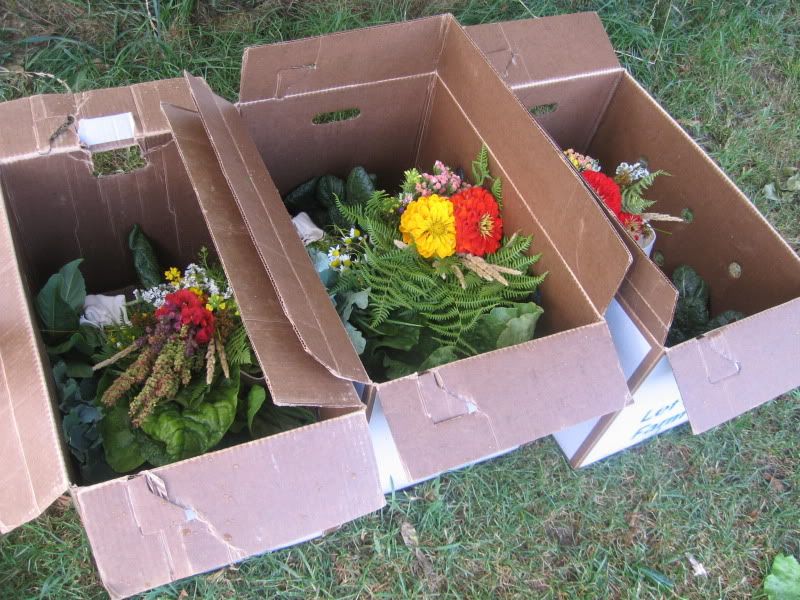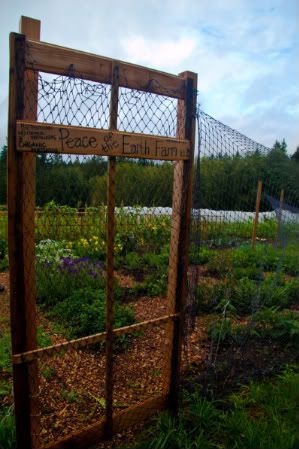I just wanted to share a passage from John Steinbeck's, The Grapes of Wrath:
"And when the horse stops work and goes into the barn there is life and a vitality left, there is breathing and a warmth, and feet shift on the straw, and the jaws clamp on the hay, and the ears and eyes are alive. There is a warmth of life in the barn, and the heat and smell of life. But when the motor of a tractor stops, it is as dead as the ore it came from. The heat goes out of it like the living heat that leaves a corpse. The corrugated iron doors are closed and the tractor man drives home to town, perhaps 20 miles away, and he need not come back for weeks or months, for the tractor is dead. And this is easy and efficient. So easy that the wonder goes out of the work, so efficient that the wonder goes out of the land and the working of it, and with the wonder the deep understanding and the relation".
We understand that our small little farm is not so efficient, and not so easy, but it is filled with wonder...a wonder we feel privileged to experience and share with our community. Thanks for being part of this with us, let's keep the wonder of the food, of the land, of the living breathing life that interacts with it, alive.
peace,
Hillary
Saturday, July 25, 2009
Sunday, July 19, 2009
An Incredible Organization
Hello Peace of the Earth family! Hillary and I met a neighbor of ours a few weeks back and he shared with us some amazing things he is doing in Central America. Michael has created a blog about his efforts and the struggles of the Guatemalan people. You can find the blog at:
http://therippleeffectinc.blogspot.com/
Support Michael and his incredible organization.
Brian
http://therippleeffectinc.blogspot.com/
Support Michael and his incredible organization.
Brian
Thursday, July 9, 2009
First CSA Boxes Successfully Delivered!
Wednesday, July 8, 2009
A quick correction:
Hi all, I just realized that I called the "guard" leaf on my tomato trellising blog the "ground". Guard I believe is the correct term and not ground. I got in the habit once of calling it the ground and you know how habits are. Also, figure two is pretty much how the plant should look when you're done pruning... the light grayish leaves in the figure represent what will be cut. In reality you'll most likely cut A LOT more leaves then that. I simplified it for the figure so it would be more clear.
Sunday, July 5, 2009
Tomato Trellising and Pruning
It seems like everyone has their own way of pruning and trellising tomatoes and of course everyone claims to have the best method. Well, I don't want to claim that this is is the best method but it is what I have been taught and It seems to work pretty well. This is the method that Steve Solomon, author of many gardening books, most notably Gardening West of the Cascades, uses as well as The Evergreen State College Organic Farm where I studied sustainable agriculture.
When pruning a plant you may have to give yourself a pep talk before you begin. You might be worried you'll cut too much or cut the wrong thing. Tomatoes are pretty good at recovering if you cut too much or cut in the wrong place and secondly, most people actually cut too little when pruning. You may find it difficult to bring to yourself to cut large portions of the plant but try and remember that this will help the plant thrive. We prune because it helps focus the plant so it can get to the business of making the fruit as big and delicious as possible. If we don't prune, the plant will keep setting out as much leafy growth and fruit as possible....you'll get more growth and more fruit, but the flavor and size of the tomatoes will not be as desirable. Furthermore, your plant will be more susceptible to disease if your don't prune because of overcrowding of the leaves. Pruning gets the leaves and fruit up off the soil, and promotes better air circulation, both of which can help against disease.
Begin by first understanding the tomato plant's anatomy. In it's most basic state you have three main parts: the stem, the ground and the leader. The ground comes out of the main stem and the leader is right above the ground (figure 1).
Figure 1 (remember to clock on the photo for the full image)
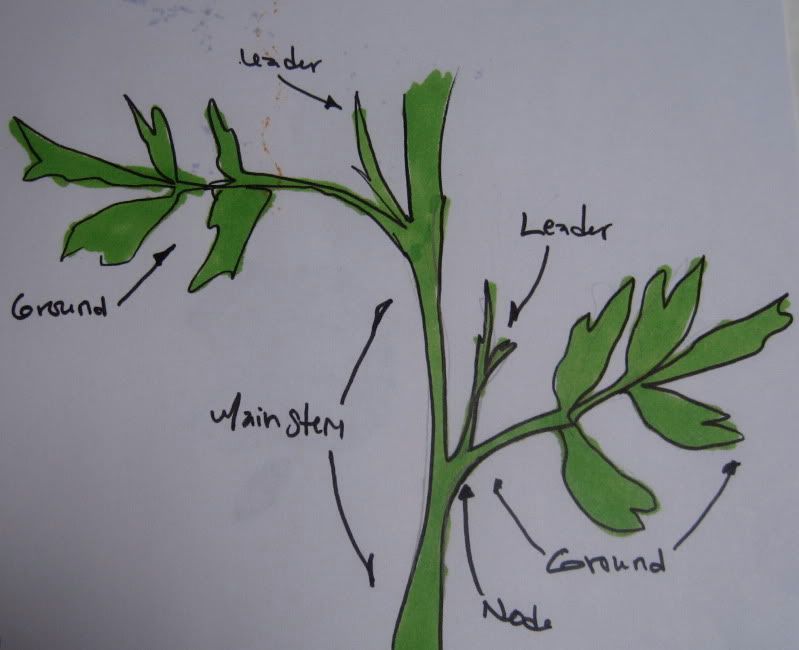
Once you understand the anatomy it is now time to do some cutting. I like to start by cleaning house. The first thing I do is cut all the suckers that start to sprout at the base of the plant. Next cut the grounds and leaders toward the bottom of the plant. You don't want a single leave touching the soil. You may need to cut off leaves as far up as 12 inches up the stem. When pruning with this method it is recommended to prune the plant down to two leaders. While you are doing these initial cuttings start trying to determine where the primary leader is, and which leader you will choose for the secondary leader (figure 2). I usually choose a leader that is fairly hardy, one that already has fruit or flowers forming, and one that is about 12 to 18 inches from the soil. I like to mentally choose a few potential candidates for the secondary leader and hold off on cutting those until I know for sure which one I'll leave. Most of the leaders will be fairly small and can easily be pinched off with your fingers, others might need a snip from some siccors.
Figure 2 (remember to click on the photo for the full image)

Of course it's usually never as perfect as figure 2 but you might be surprised at how similar your plant may look to figure 2 after you're done cutting back all the leaders.
Now it's is time to trellis the tomato plant. We use a string method. Most people try to prop the plant up using stakes or cages in an effort to combat the plants desire to follow the laws of gravity. In my opinion this is a fool hardy goal as gravity will always win and you will create a lot more work for yourself as the tomatoes get bigger and heavier. Many people are very attached to their stakes and cages and refuse to give them up, however, I implore you to try out the string method because most people find it requires a lot less maitence as the season goes on.
First drive large posts (at least 6 feet) into the ground at both end of your tomato row. Then string either wire or hardy bailing twine from one post to the other (see photo below). Then hang two pieces of bailing twine down for each tomato plant. Tie both strings to the bottom of the plant and then gently guide the plant around the strings. When you get the point when your primary leader goes one way and your secondary leader goes the other, guide one string with the primary leader and one string to the secondary leader (figure 2). Make sure the strings are fairly taught so the plant is held up. This method uses gravity to it's advantage because the plants just hang there comfortable. The tomato plant might need a little help around the twine as it grows larger, but this maintenance is fairly easy and only takes a few seconds on each plant. While you do this maintenance you should also take a few seconds to pinch off any leaders that may have started to grow since you pruned.
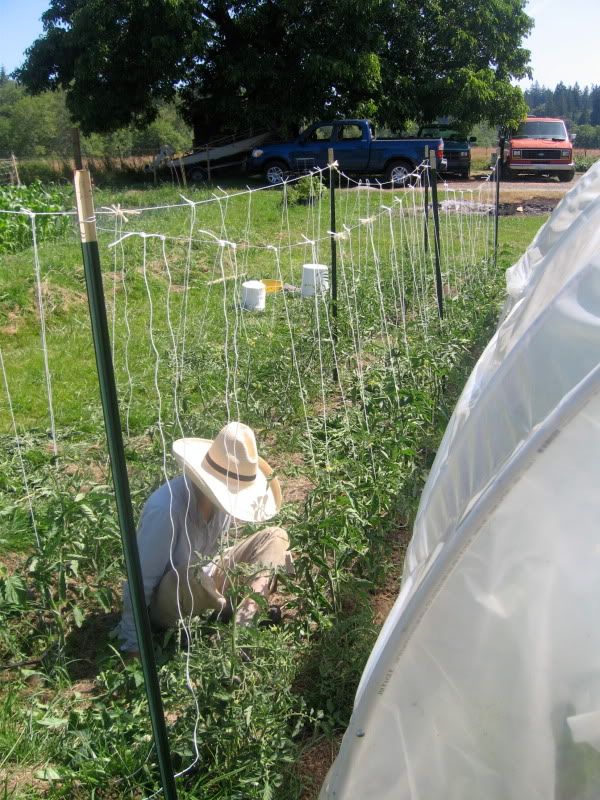
One more note about pruning: Sometimes people will leave more than two leaders early in the fruiting season. This is because you can let these additional leaders fruit once before you prune them off. It just depends on how much maintenance you want to put into the plant and how much fruit you need to get off of it. Good luck and happy trellising and pruning!
When pruning a plant you may have to give yourself a pep talk before you begin. You might be worried you'll cut too much or cut the wrong thing. Tomatoes are pretty good at recovering if you cut too much or cut in the wrong place and secondly, most people actually cut too little when pruning. You may find it difficult to bring to yourself to cut large portions of the plant but try and remember that this will help the plant thrive. We prune because it helps focus the plant so it can get to the business of making the fruit as big and delicious as possible. If we don't prune, the plant will keep setting out as much leafy growth and fruit as possible....you'll get more growth and more fruit, but the flavor and size of the tomatoes will not be as desirable. Furthermore, your plant will be more susceptible to disease if your don't prune because of overcrowding of the leaves. Pruning gets the leaves and fruit up off the soil, and promotes better air circulation, both of which can help against disease.
Begin by first understanding the tomato plant's anatomy. In it's most basic state you have three main parts: the stem, the ground and the leader. The ground comes out of the main stem and the leader is right above the ground (figure 1).
Figure 1 (remember to clock on the photo for the full image)

Once you understand the anatomy it is now time to do some cutting. I like to start by cleaning house. The first thing I do is cut all the suckers that start to sprout at the base of the plant. Next cut the grounds and leaders toward the bottom of the plant. You don't want a single leave touching the soil. You may need to cut off leaves as far up as 12 inches up the stem. When pruning with this method it is recommended to prune the plant down to two leaders. While you are doing these initial cuttings start trying to determine where the primary leader is, and which leader you will choose for the secondary leader (figure 2). I usually choose a leader that is fairly hardy, one that already has fruit or flowers forming, and one that is about 12 to 18 inches from the soil. I like to mentally choose a few potential candidates for the secondary leader and hold off on cutting those until I know for sure which one I'll leave. Most of the leaders will be fairly small and can easily be pinched off with your fingers, others might need a snip from some siccors.
Figure 2 (remember to click on the photo for the full image)

Of course it's usually never as perfect as figure 2 but you might be surprised at how similar your plant may look to figure 2 after you're done cutting back all the leaders.
Now it's is time to trellis the tomato plant. We use a string method. Most people try to prop the plant up using stakes or cages in an effort to combat the plants desire to follow the laws of gravity. In my opinion this is a fool hardy goal as gravity will always win and you will create a lot more work for yourself as the tomatoes get bigger and heavier. Many people are very attached to their stakes and cages and refuse to give them up, however, I implore you to try out the string method because most people find it requires a lot less maitence as the season goes on.
First drive large posts (at least 6 feet) into the ground at both end of your tomato row. Then string either wire or hardy bailing twine from one post to the other (see photo below). Then hang two pieces of bailing twine down for each tomato plant. Tie both strings to the bottom of the plant and then gently guide the plant around the strings. When you get the point when your primary leader goes one way and your secondary leader goes the other, guide one string with the primary leader and one string to the secondary leader (figure 2). Make sure the strings are fairly taught so the plant is held up. This method uses gravity to it's advantage because the plants just hang there comfortable. The tomato plant might need a little help around the twine as it grows larger, but this maintenance is fairly easy and only takes a few seconds on each plant. While you do this maintenance you should also take a few seconds to pinch off any leaders that may have started to grow since you pruned.

One more note about pruning: Sometimes people will leave more than two leaders early in the fruiting season. This is because you can let these additional leaders fruit once before you prune them off. It just depends on how much maintenance you want to put into the plant and how much fruit you need to get off of it. Good luck and happy trellising and pruning!
Saturday, July 4, 2009
Early July Photos
Hello all! We hope you'll enjoy these recent pictures of the farm. Remember to click on the photo for the entire image :)
We are about two thirds of the way through with our tomato trellising....a bit behind schedule but we'll get there. We are hoping to have our first ripe tomatoes by next week which should make our CSA customers very happy. If tomatoes don't make into this week's box they are sure to make it into the next week's. The beans we planted two weeks are ago are doing very well and the kohlrabi bulbs are starting to form. We just thinned our first succession of carrots and the beets are now about the size of a golf ball. All of the squash plants seem to be flourishing and you can almost watch it grown right before your eyes. The flowers are all starting to bloom just in time to make our first bouquets this week for our CSA customers. Corn is about waist high!
peace!



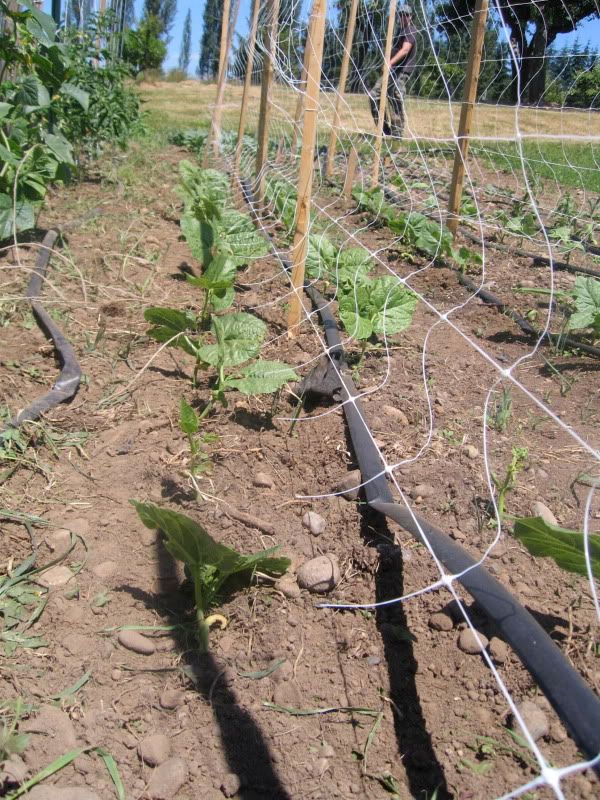
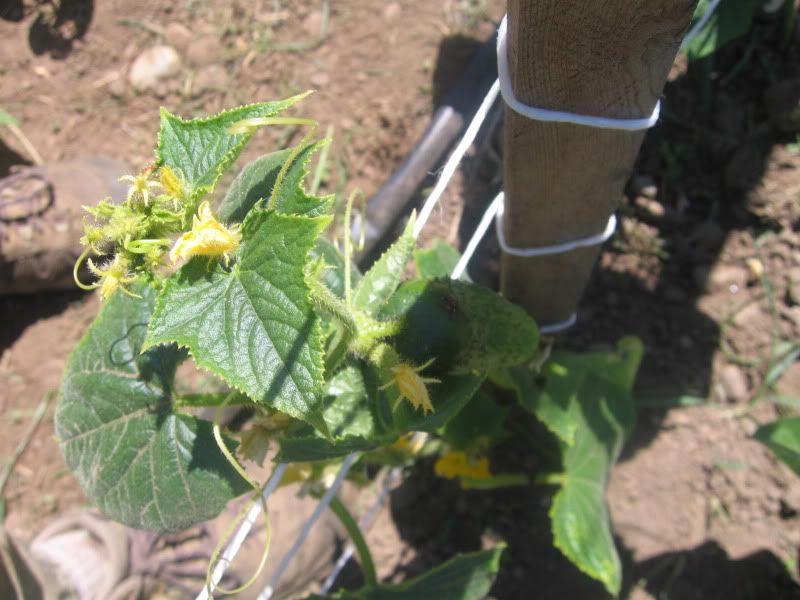





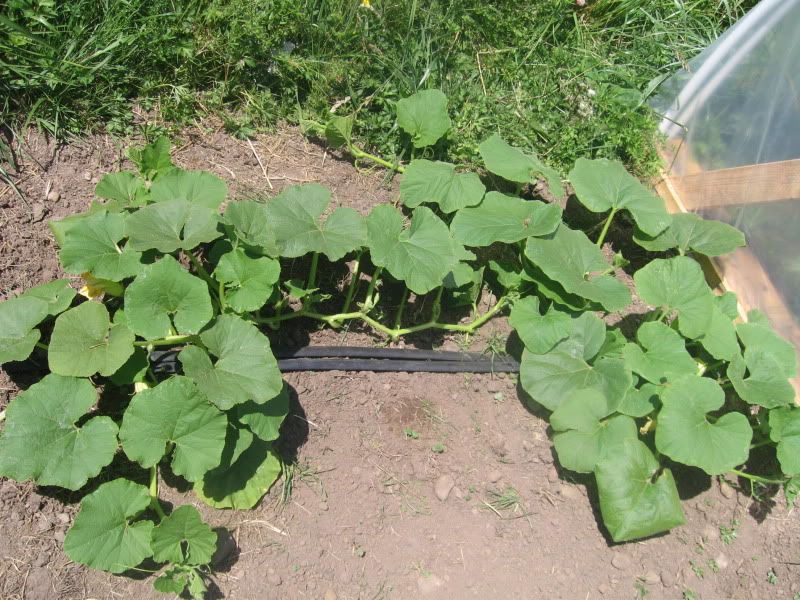
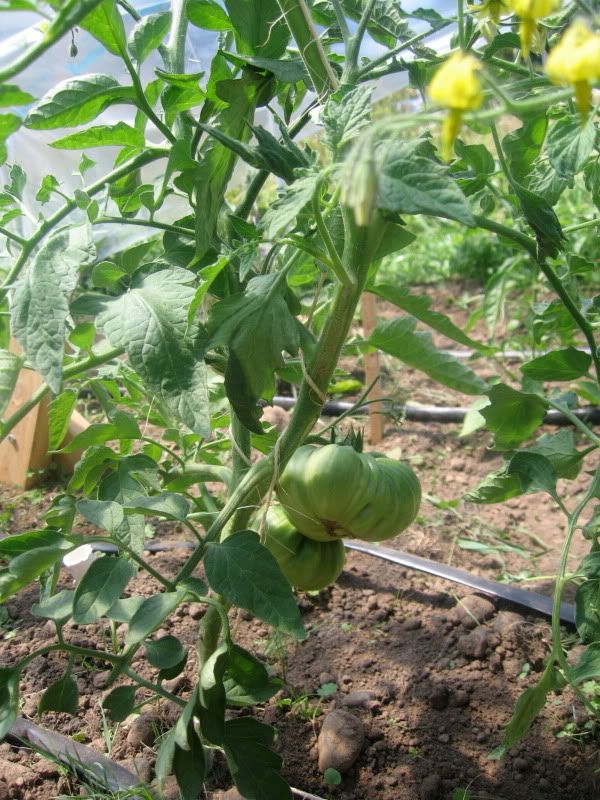
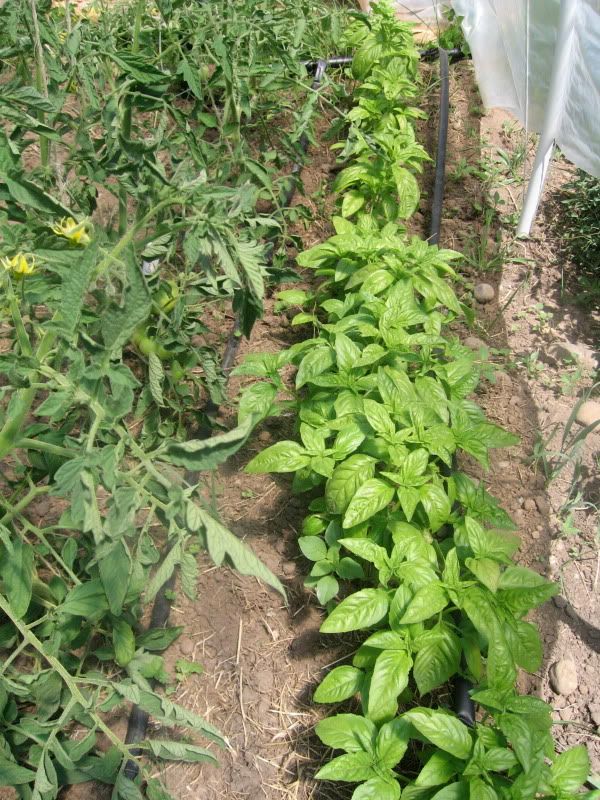
We are about two thirds of the way through with our tomato trellising....a bit behind schedule but we'll get there. We are hoping to have our first ripe tomatoes by next week which should make our CSA customers very happy. If tomatoes don't make into this week's box they are sure to make it into the next week's. The beans we planted two weeks are ago are doing very well and the kohlrabi bulbs are starting to form. We just thinned our first succession of carrots and the beets are now about the size of a golf ball. All of the squash plants seem to be flourishing and you can almost watch it grown right before your eyes. The flowers are all starting to bloom just in time to make our first bouquets this week for our CSA customers. Corn is about waist high!
peace!













Wednesday, July 1, 2009
We are starting a Community Supported Agriculture (CSA) Program!
We are looking for 2 to 4 local families or individuals to join our brand new Community Supported Agriculture Program (CSA). A CSA is a partnership between you and your farmer in which you receive a box of freshly harvested food and flowers every week for a set amount of weeks. A CSA is a wonderful way to support your local farmers as well as supply your family with the freshest and most healthy food available.
If you have been following this blog then you know that our farm values fresh food, high crop diversity, community interaction, health of the "agro-ecosystem" as well as sustainable and organic methods of farming. If you value these things as well, perhaps this CSA is for you.
Here's how it works:
Since this is our first year as an official farm we are offering our CSA at a discounted price. Most CSA programs range from about $25 to $50 a week. We are offering our CSA for $20 a week for our first year mainly because we realize that as we fine tune the process there could be a few bumps in the road. CSA programs can range from 8 to 24 weeks, or even year round. We will start our first CSA program off with a 12 week, prepaid, program ($240). Our CSA will start the week of July 13th, and run through the week of September 28th. Each week you will pick up a box of freshly harvested food and a flower bouquet right from the farm. Each box will contain enough vegetables for about 2 to 4 adults and a freshly picked bouquet of flowers. Depending on what is ready to be harvested a box might contain a mixture of lettuce, beets, carrots, kale, swiss chard, onions, kohlrabi, broccoli, corn, tomatoes, peppers, eggplant, squash, basil, and/or apples.
In the coming years we plan to become organically certified, expand the farm and include a lot more variety including more fruits, and possibly eggs, milk, cheese and meat. Believe it or not, if you choose to take part in this CSA program, you will be part of that because you are helping us build the foundation of our farm. Our most important shares will be our first shares. We want you to know that as one of our first CSA customers you are truly helping to ensure the success of your local farmers. Things might not be perfect however, and we want to make sure you understand fully what a CSA truly means. The most important aspect of a CSA is the word community; we will help each other!
Since this is our first year, we only have enough food to support 2 to 4 CSA shares so please contact us as soon as possible to ensure your spot. We also want to make sure that since we are embarking on a partnership that we are a good fit for each other. Please contact us with a few sentences about your interest in sustainable agriculture, fresh healthy foods, and your feelings about having a CSA in your community.
Please contact us via email at peaceoftheearthfarm@gmail.com if you are interested.
If you have been following this blog then you know that our farm values fresh food, high crop diversity, community interaction, health of the "agro-ecosystem" as well as sustainable and organic methods of farming. If you value these things as well, perhaps this CSA is for you.
Here's how it works:
Since this is our first year as an official farm we are offering our CSA at a discounted price. Most CSA programs range from about $25 to $50 a week. We are offering our CSA for $20 a week for our first year mainly because we realize that as we fine tune the process there could be a few bumps in the road. CSA programs can range from 8 to 24 weeks, or even year round. We will start our first CSA program off with a 12 week, prepaid, program ($240). Our CSA will start the week of July 13th, and run through the week of September 28th. Each week you will pick up a box of freshly harvested food and a flower bouquet right from the farm. Each box will contain enough vegetables for about 2 to 4 adults and a freshly picked bouquet of flowers. Depending on what is ready to be harvested a box might contain a mixture of lettuce, beets, carrots, kale, swiss chard, onions, kohlrabi, broccoli, corn, tomatoes, peppers, eggplant, squash, basil, and/or apples.
In the coming years we plan to become organically certified, expand the farm and include a lot more variety including more fruits, and possibly eggs, milk, cheese and meat. Believe it or not, if you choose to take part in this CSA program, you will be part of that because you are helping us build the foundation of our farm. Our most important shares will be our first shares. We want you to know that as one of our first CSA customers you are truly helping to ensure the success of your local farmers. Things might not be perfect however, and we want to make sure you understand fully what a CSA truly means. The most important aspect of a CSA is the word community; we will help each other!
Since this is our first year, we only have enough food to support 2 to 4 CSA shares so please contact us as soon as possible to ensure your spot. We also want to make sure that since we are embarking on a partnership that we are a good fit for each other. Please contact us with a few sentences about your interest in sustainable agriculture, fresh healthy foods, and your feelings about having a CSA in your community.
Please contact us via email at peaceoftheearthfarm@gmail.com if you are interested.
Subscribe to:
Posts (Atom)
